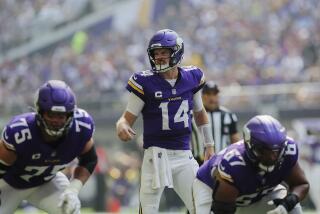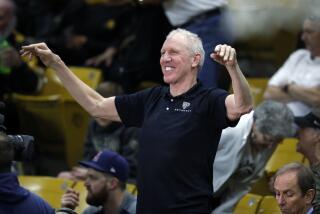Just an Old Dude? Hardly : Former Rose Bowl MVP Jim Hardy Finds New Friends and Young Fans at La Quinta High
- Share via
LA QUINTA — Fifty football seasons after he was the most valuable player in the Rose Bowl game, Jim Hardy, at 71, decided to go into coaching.
“I had to think it over first,” a winking Hardy explained recently.
The former USC and seven-year NFL quarterback became a volunteer quarterback coach last summer at the new La Quinta High, about a mile from his desert home.
Hardy led USC to consecutive victories in the 1944 and 1945 Rose Bowls. The Trojans beat Washington in the 1944 game, 29-0, and Tennessee in 1945, 25-0.
He was the Rose Bowl MVP in 1945.
Fifty years ago, Hardy was big news.
So big he nearly put World War II below the fold.
The framed L.A. Times front page of Jan. 2, 1945, hanging on his den wall, bears this monster headline, across the top:
“SC BEATS VOLS, 25-0”
Underneath is a much smaller headline, near the fold:
“Patton Hammers Germans in Belgium as Nazis Open New Smashes at 7th Army”
After spending the last months of the war in the Pacific in a Navy uniform, Hardy played for the Rams, Chicago Cardinals and Detroit Lions in a pro career that ended in 1953.
In August, retired and living in La Quinta, he lingered over a local newspaper story about the new high school opening in his neighborhood that was having tryouts for its freshman and junior varsity football teams.
“I’d always wanted to write a story about the development of a new football program, from genesis to a championship, so I thought this might be my chance,” he said.
When the school’s coach, Dan Armstrong, called his first meeting last August, Hardy showed up and introduced himself.
“The name Jim Hardy kind of rang a bell, but I really didn’t know who he was,” said Armstrong, 41.
“He didn’t know me from a load of hay,” Hardy said.
“I didn’t expect any of the coaches to know me. None of them were even born when I quit playing.”
Hardy attended the first practices, took notes, then began studying two young quarterback candidates, Pancho Munoz and Jeremiah Anderson.
Finally, he couldn’t resist.
He approached Armstrong and said, “Do you mind if I work with your quarterbacks now and then? I’ve got a little football background.”
Recalled Armstrong: “He started working on technique stuff with the quarterbacks, and they seemed to like him. He was connecting with them.”
Then, Hardy’s fame fell out of the sky on the astonished La Quinta High Blackhawks.
Late last August, he was inducted into the Rose Bowl Hall of Fame, an event covered on television. Mouth agape, Armstrong saw it on TV that night, as did several of his players.
“The next day at practice, I asked Jim how come he never told us he’d played in the Rose Bowl and the NFL, and he just said, ‘It wasn’t important.’
“Two players had rushed into my office that morning and said, ‘Coach! Coach Hardy is famous! We saw him on TV last night!’
“We should have known. I remember the first day he passed a football at practice, I said to someone, ‘That guy may be 70, but he can still throw a great ball.’
“All of a sudden, this guy isn’t some old know-it-all. Suddenly, what he told the kids became gospel. He became a very effective coach after that. When he cleared his throat, everyone turned to look at him.
“He wore his Detroit Lions world championship ring (from 1952) to a couple of practices, and that was a big hit too.”
From there, Hardy made every practice, every game, and every bus ride. He even put the game program in the black.
“We needed money for equipment, and I mentioned a problem to him once that we couldn’t seem to get any ads in the program. He took over that job and filled it up.”
Anderson, one of the La Quinta quarterbacks, said he at first thought Hardy was “just an old dude.”
“Then one day he passed the ball about 50 yards and I thought, whoa! Who is this guy?
“Then when we learned who he really was, we had a sense of pride that he’d picked us to work with. And I really learned a lot from him.
“He was great at showing me how not to think of defensive pressure around me, to blot that out and to concentrate on finding receivers. It’s hard to do, but he makes it easy to learn because he never criticizes you, never says you did something badly.”
Meanwhile, at USC, many wondered what had happened to Jim Hardy.
One of the most loyal of all former Trojans, Hardy had attended more USC practices in 1993 than any other former player. But suddenly he was into coaching.
Recalled his wife, Henrietta: “Jim can be a very stubborn guy. If (the La Quinta coaches) had knocked on our door and asked him to help them out, he’d have said no. But he saw that story in the paper and made a decision to help out on his own terms.”
La Quinta had a 6-3-1 season, and Hardy talks with friends about his adopted team as often as he talks about his beloved Trojans.
“We’ve got a 14-year-old running back at La Quinta, Neal DeMario, who’s star material,” Hardy said.
“He’s six feet, 180 pounds and has moves you can’t coach. And there’s also a 14-year-old freshman lineman, Brian Heslin, who’s 6-2 and 220 already.
“I really enjoy working with these kids, showing them all the little things a quarterback needs to know--like making sure the handoff goes to the back’s belt buckle. Any higher and he has to straighten up, he slows down, gets creamed and maybe fumbles.
“And above all, I really enjoy helping Dan, because he’s really an outstanding young coach.”
Having “Old Dude” Hardy around has meant more benefits to the coach than record program sales too.
“He knows everyone in football,” Armstrong said.
“He got me a golf game with John McKay. The coaching staff loves just sitting around with him and hearing his stories about going out on the town with Bobby Layne and Norm Van Brocklin.”
*
At their home, Jim and Henrietta Hardy, who on June 1 will have been married 50 years, talked of cheap dates in the late 1930s and ‘40s.
Life is good. There’s a home in the desert, golf, old friends. But there’s one problem: No place to dance anymore.
“We danced at the Palladium in Hollywood the first night it was open to the public, for 90 cents each,” Jim said.
“They had food there, but all we had was the 90 cents. So we just kept dancing until they blinked the lights at us.
“We also used to dance at the Palomar, at Second and Vermont, until it burned down in 1939. And we danced to Stan Kenton’s music at the Rendezvous in Balboa.”
When Henrietta left for a shopping expedition, Hardy said, “There goes the greatest swing dancer who ever lived.”
More to Read
Go beyond the scoreboard
Get the latest on L.A.'s teams in the daily Sports Report newsletter.
You may occasionally receive promotional content from the Los Angeles Times.






